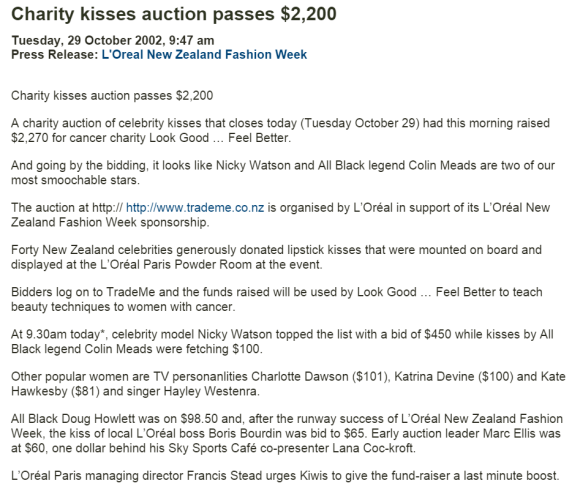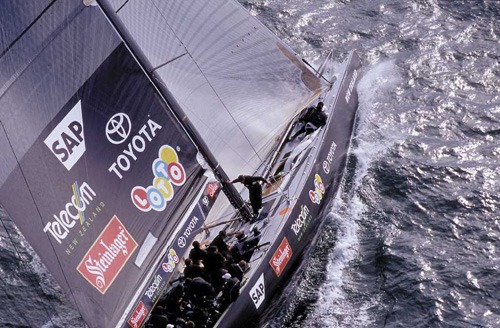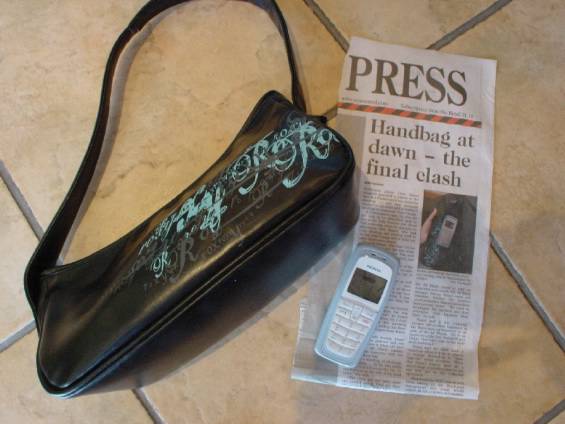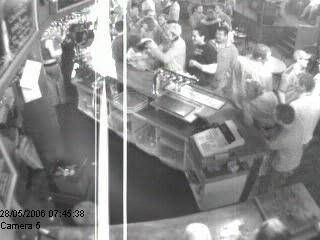Wow! It was Trade Me’s 20th Birthday last week. How time flies.
It seems like it was only yesterday — though it was actually 14 years ago — that we were writing the first edition of TRADE ME SUCCESS SECRETS, the top-selling book about the little Kiwi website that could — and did.
Back in 1999, in the earliest days of the auction website’s existence, it was a cause for celebration at Trade Me if an item on the site was listed by someone who wasn’t personally known to the founders or staff.
The site grew slowly. By the time of Trade Me’s first anniversary, in March 2000, Trade Me boasted 7,350 listings that month.
Growth continued, year on year, as more and more Kiwis discovered Trade Me, and the pace increased. By March 2005 Trade Me was carrying 1,568,175 listings a month.
Nowadays, Trade Me more typically carries around 7 million listings a week — although this week, thanks to a special birthday promotion last Saturday offering zero success fees for general items listed that day, Trade Me is currently carrying a record-breaking 8,380,874 listings!
So how do you get your listings noticed amongst more than 8 million competitors on Trade Me?
Well, we’ve actually written a course about that very topic (about which more in a moment), but first, from our book Trade Me Success Secrets, here are some of the site’s most popular listings:
Attracting Traffic to Your Listing
if you’re running an auction, you want as many people as possible to be aware of the fact, so there’s a tendency for sellers to make as much noise as possible about their auctions — which inevitably benefits the auction venue as well.
Trade Me’s initial growth was fuelled by word of mouth from satisfied customers and also from the publicity generated by the many high-profile auctions that have been conducted on the site over the years.
As far back as 2002, L’Oreal featured on the Trade Me site as the sponsor of a Celebrity Kisses auction in support of Fashion Week. Forty Kiwi celebrities donated lipstick kisses that were mounted on board and displayed during Fashion Week events. Trade Me membership in 2002 was just a fraction of today’s numbers, but bidding was still spirited. Top bid: $550 for a smooch from Nicky Watson — nearly three times more desirable than her nearest competitor.
More importantly for L’Oreal (and Trade Me), the 40 celebrities attracted a total of 35,535 page views during the course of that campaign.
Another 2002 initiative, The Great Team New Zealand Auction, a major fundraising drive undertaken by Bayleys Real Estate for Team New Zealand, raised more than $1.7 million for the team’s short-lived defence of the illustrious America’s Cup.
The initiative was a two-pronged effort, involving both a Trade Me auction and a live auction dinner for 900 people. The outstanding result again attracted favourable publicity for Trade Me.
Among other high-profile items that made an impact on — and created publicity for — Trade Me:
A polo shirt autographed by actor Tom Cruise (during his stint in New Zealand filming The Last Samurai) fetched $900 for the Child Cancer Foundation in 2003.
A lollipop half-sucked by actor Orlando Bloom at the world premiere of The Lord of the Rings: The Return of the King (we’re not making this up!) attracted more than 11,000 views. The seller: The Edge FM, raising funds for charity, so at least Orlando’s DNA went for a good cause.
One-of-a-kind Dr Martens boots customised by the likes of Karen Walker, World, Tanya Carlson, Nom D and Zambesi were auctioned on behalf of the New Zealand Aids Foundation.
Love letters written by more than 40 New Zealand celebrities and sporting greats were auctioned off in aid of Variety, the Children’s Charity.
And then there was what we still consider the most viewed Trade Me auction of all:
The auction, still regarded as Trade Me’s most popular auction ever, was for a woman’s handbag — the weapon of choice for All Black captain Tana Umaga in a Christchurch bar on an early Sunday morning in late May 2006.
According to news reports at the time:
Patrons at a Christchurch bar say they watched in disbelief as former All Black captain Tana Umaga struck a teammate in the head with a woman’s handbag.
Umaga is said to have hit Hurricanes teammate and All Black Chris Masoe in response to Masoe allegedly attacking a bar patron at The Jolly Poacher tavern between 6.30am and 8am [on Sunday morning].
The media were all over this story in the days that followed, interviewing anyone who had been in or near the bar or who could bring a new angle to the occasion. The All Black and the Handbag was a natural news story.
In other words, the story of the event had already achieved monster status. When the offending article was listed on Trade Me by the Friday after the event, interest was already white hot. Viral success was inevitable, even though the information contained in the listing was slight:
Hurricanes Handbag & Cellphone
These are the genuine articles.
Handbag was used by Tana Umaga to hit Chris Masoe at the Jolly Poacher in Christchurch after the Super 14 final. Cellphone that was broken in this bar incident is also included.
This can be verified as the genuine articles at time of purchase.
Please note this has been listed on owners behalf.
What makes such a story newsworthy? The Media College sheds some light on five key factors:
Timing
The word news means exactly that – things which are new. Topics which are current are good news. Consumers are used to receiving the latest updates, and there is so much news about that old news is quickly discarded.
A story with only average interest needs to be told quickly if it is to be told at all. If it happened today, it’s news. If the same thing happened last week, it’s no longer interesting.
[OUR COMMENT: The Tana Umaga tale was still hot when the auction listing went up — and journalists were ready for a new spin. Excellent timing.]
Significance
The number of people affected by the story is important. A plane crash in which hundreds of people died is more significant than a crash killing a dozen.
[OUR COMMENT: Tana was an All Black — and a well-respected one, at that. Significance was high]
Proximity
Stories which happen near to us have more significance. The closer the story to home, the more newsworthy it is. For someone living in France, a major plane crash in the USA has a similar news value to a small plane crash near Paris.
[OUR COMMENT: A local occurrence, and our own legendary rugby team]
Prominence
Famous people get more coverage just because they are famous. If you break your arm it won’t make the news, but if the Queen of England breaks her arm it’s big news.
[OUR COMMENT: One All Black hitting another All Black, with a completely unexpected and counterintuitive weapon. Celebrity Knockout!]
Human Interest
Human interest stories are a bit of a special case. They often disregard the main rules of newsworthiness; for example, they don’t date as quickly, they need not affect a large number of people, and it may not matter where in the world the story takes place.
Human interest stories appeal to emotion. They aim to evoke responses such as amusement or sadness. Television news programs often place a humorous or quirky story at the end of the show to finish on a feel-good note. Newspapers often have a dedicated area for offbeat or interesting items.
[OUR COMMENT: This story hit all those buttons as well]
With all that going for it, no wonder the auction went ballistic. Michael O’Donnell’s book “Trade Me: The Inside Story” (Phantom House, Wellington, August 2010) gives the final numbers:
Start/Reserve Price: $1500
Sale Price: $22,800
Number of pageviews: 1.05 million
Number of bids: 194
Number of questions: 283
Number of complaints; 86
Poor Timing
There’s a sequel to this story. A week later, thirty seconds of security camera footage from the Jolly Poacher Hotel was listed on Trade Me, in a belated attempt to cash in on the action.
Too little, too late. The buzz was gone, and so were the bidders. The item was passed in without hitting its reserve price.
Learnings from Tana
The first and most important lesson from Trade Me’s most successful auction is this: if you’re part of a significant and newsworthy event and are in the position (and of a mind) to take advantage of existing news coverage, act fast. Timing is everything.
Secondly, fan the flames — talk to journalists (and anyone else with a significant following) and get the word out fast. Also keep them up to speed with the latest developments so they can keep the story alive in their own medium.
Third, keep the auction period short. The handbag listing was only live for three days so interest was maintained.
Fourth, interact. Encourage questions and respond quickly to any as they are asked. The Tana auction reportedly attracted 3,000 questions/comments — the person listing the item managed to respond to 300 of them. The ebb and flow of questions provides fresh content that encourages browsers to come back and see what’s being said — and then join in the fun (even if they’re not bidding) by tossing in their own comments. That in turn encourages casual visitors to share the unfolding story with their friends.
What do these auctions have in common? Primarily, the fact that they’ve tapped into celebrity power, often in the aid of good causes. The combination not only makes for highly saleable items, but also makes them newsworthy — good news for the charities, the organisers and for Trade Me.
How to Sell Effectively on Trade Me
The listings above managed to catch lightning in a bottle. But what if your listings are more pedestrian? What if you aren’t selling for charity, don’t have celebrity involvement and don’t have a newsworthy item?
In such cases, we recommend that you take a look at that course we mentioned earlier (along with a very special offer, this week only):
Trade Me Advanced Selling Secrets
So you’ve been buying and selling on Trade Me for a while and now you want to turn your Trade Me dealings into a profitable business?
As you’ll quickly find out, that’s not as easy as it looks. Sure, it’s simple to set yourself up as a seller and join the many thousands who sell on Trade Me — but if you want to make some serious money doing business on Trade Me, you have to do your homework first. And who better to advise you than Michael Carney, author of Trade Me Success Secrets, who has been analysing and advising about Trade Me since 2005?
This is a seven-week eCourse providing a comprehensive masterclass on selling on Trade Me. The course presumes you are already familiar with the basics of selling on Trade Me (if there are a few gaps, you can do your homework with our own TRADE ME SUCCESS SECRETS book).
This is an ONLINE-ONLY course — you can take part from anywhere, in your own time.
This eCourse is conducted on a web-based e-learning software platform, enabling course participants to proceed at their own pace, accessing materials online. This particular eCourse provides content in a variety of multimedia forms, including videos, slideshows, flash-based presentations and PDF files. No special software is required to participate.
Course lessons are released weekly, for participants to access in accordance with their own timetables. Interaction with the course tutor is enabled through the platform software tools (with telephone backup if required).
The course is self-administered — questions and assignments are of a practical nature and are all intended to help participants develop their skills at trading on the site.
COURSE CREATION
This course has been created by Michael Carney, author of the best-selling book about buying and selling effectively on Trade Me, TRADE ME SUCCESS SECRETS (now in its second edition).
WHO SHOULD TAKE PART
Anyone who wants to sell as effectively and profitably as possible on Trade Me.
——————————————————————————–
COURSE CONTENTS
INTRODUCTION
In which we discuss the secrets of selling successfully on Trade Me, identify the various elements we’ll be covering during the course and examine the skills you’ll need to have (or hire in) as your selling operation expands. At the end of this section we’ll be setting a self-assessment questionnaire to determine if you have what it takes to be a top Trade Me seller.
LESSON ONE: ABOUT THE BUYERS
We talk about the buyers, discuss what makes them buy (or not), review current economic conditions and explore their motivations (and how we can trigger the urge to buy). We also look at what times of the day and times of the week they’re most likely to visit Trade Me, what times of year they’re most likely to be looking for Trade Me deals — and how you can keep watch on their current interests. Your homework will focus on identifying the most likely buyers you think would be interested in your products — or choosing desirable buyers and then identifying their particular needs and wants.
LESSON TWO: PRODUCTS THAT SELL
We’ve gathered years of information on which products sell well on Trade Me. In Lesson Two we look at the products that always sell well and the items that have been especially hot recently. Your assignment for this lesson: pimp your own products — what can you do to make them Uniquely You?
LESSON THREE: TOP SELLERS & THEIR STORIES
We spoke to many top sellers when we put together TRADE ME SUCCESS SECRETS. In this lesson we explore who are the top selling traders on Trade Me these days and what they’re doing especially well. Your mission, should you decide to accept it: identify some of the key learnings that are relevant to you.
LESSON FOUR: GETTING NOTICED
Sometimes, it’s easy to see why an auction goes viral and picks up hundreds of thousands of pageviews. When Tana Umaga picked up that handbag and demonstrated Management By Hitting Out, the cybersphere went wild. But what happened to turn that Scary Washing Machine into a phenomenon? We talk to those involved and identify some of the strategies that make auctions sizzle. And we look at the increasing importance of Twitter and Facebook to get the word out. Your task: review some of your own auction listings to see which measure up.
LESSON FIVE: KILLER CONTENT
Words matter on Trade Me. If you don’t have a compelling headline, your listing won’t even get read. If you don’t have a sizzling description, you won’t get added to anybody’s waitlist. And if the accompanying pictures don’t make your item a must-have addition to your collection, forget it. We take you through the processes and then turn you loose on your own listings.
LESSON SIX: HOW MUCH?
What sorts of prices should you set for your products on Trade Me, to give you a fair return on the time and effort involved? What are the little tricks for squeezing more revenue out of the site? When are loss leaders (such as $1 No Reserve listings) appropriate? We examine the numbers — and then encourage you to do likewise.
LESSON SEVEN: GETTING THINGS DONE
Once you reach a certain point on Trade Me, you need to introduce systems (unless you simply don’t want a life). We look at what’s now available to create your listings, post them quickly, get the products out the door — and then handle those after-sales deals such as feedback. We also look at how you can build a list of satisfied customers — and turn that happiness into additional revenues. Your homework will involve planning your growth strategy.
CONCLUSION
Time to turn all that learning into a planned sales programme. We give you the tools (or tell you where to find them).
——————————————————————————-
TIMING
The next course begins on Thursday 18 December, 2025.
This seven-part eCourse is available for $597+GST. However, we offer an Early Bird Booking Discount of $100 for bookings and payment received by Thursday 11 December, 2025, so you only pay $497+GST.
Bookings are confirmed on receipt of payment, which can be by bank deposit or credit card. We can raise an invoice in advance if you need it [if you need an invoice or want our bank account details, email us at michael (at) trademesuccesssecrets.com].
To reserve your place in this course, please pay by credit card through PayPal by clicking here.
(The service provider will be shown as Netmarketing Courses in your transaction and on your credit card statement).
WHAT HAPPENS NEXT?
Your booking will be confirmed by email (if you have not received a confirmation within 24 hours, feel free to email michael (at) trademesuccesssecrets.com).
On the first day of the course you will be supplied by email with login details and Course Notes for the first lesson.
Further Lessons will be provided at weekly intervals for the duration of the seven-part course.







